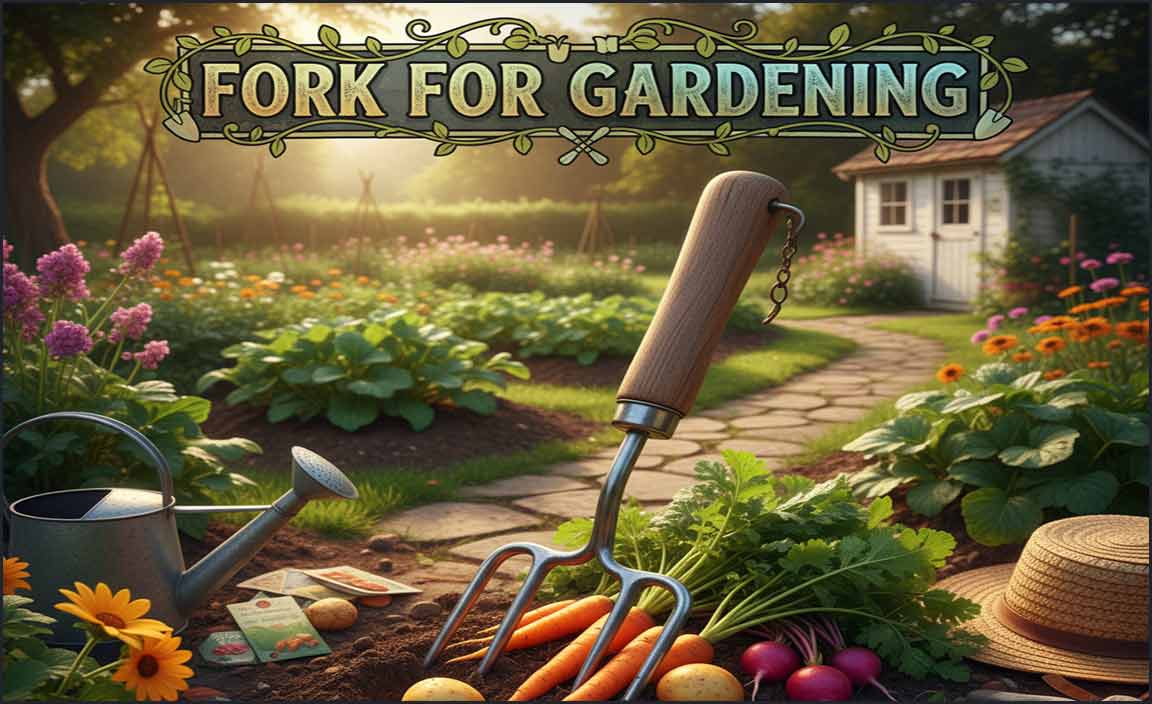Quick Summary: Selecting the best gloves for gardening ensures comfort and protection. Look for durable, breathable materials that fit well, offering excellent grip for various tasks from planting to pruning, safeguarding your hands from thorns, dirt, and moisture for a more enjoyable gardening experience.
Best Gloves for Gardening: Essential Protection for Happy Hands
Ever felt a sharp thorn prickle your hand, or noticed your skin feeling dry and rough after a long day in the garden? You’re not alone! Many beginner gardeners overlook a simple but crucial tool: a good pair of gardening gloves. It might seem like a small detail, but the right gloves can truly transform your gardening experience, turning potential discomfort into pure joy. We’ll guide you through choosing the perfect pair, so you can get back to what you love – nurturing your plants, not worrying about your hands.
Why Gardening Gloves Are a Must-Have for Every Gardener
Gardening is a wonderfully rewarding activity, connecting us with nature and providing fresh, healthy food or beautiful blooms. However, our hands are on the front lines, exposed to a variety of elements that can cause discomfort and even injury. Think about it: thorny rose bushes, prickly weeds, damp soil, abrasive compost, and even harsh cleaning agents for tools can all take a toll. Without proper protection, these can lead to cuts, scrapes, blisters, splinters, and skin irritation. For those with sensitive skin or allergies, the contact with certain plants or soils can be even more problematic.
Investing in a quality pair of gardening gloves is like giving your hands their own personal shield. They provide a barrier against these common garden hazards, keeping your skin safe and intact. More than just protection, the right gloves can enhance your grip, allowing you to handle tools and plants with more confidence and control. They also help keep your hands clean, which is a bonus for anyone who prefers not to end the day with dirt permanently under their fingernails. Let’s explore the options available and find the perfect fit for your gardening adventures, whether indoors or out.
Types of Gardening Gloves: Finding Your Perfect Match
The world of gardening gloves is surprisingly diverse! Just as you wouldn’t use the same tool for every garden task, you won’t find one glove that’s perfect for absolutely everything. Different materials and designs cater to specific needs, from delicate potting work to heavy-duty digging. Understanding these types will help you choose the absolute best gloves for gardening suited to your specific needs.
1. General Purpose Gardening Gloves
These are your everyday workhorses, designed for a good balance of protection and dexterity. They are typically made from materials like cotton, polyester, or a blend, often coated with latex or nitrile for added grip and water resistance. They’re ideal for tasks like weeding, planting seedlings, and general soil work.
- Pros: Versatile, affordable, breathable (depending on material), good for light to moderate tasks.
- Cons: May not offer enough protection for very thorny plants or extended wet conditions.
2. Leather Gardening Gloves
Leather gloves are highly regarded for their durability and toughness. They offer excellent protection against thorns, splinters, and abrasion, making them a favorite for pruning roses, handling rough materials, and heavier-duty landscaping. The best leather gloves are made from supple, high-quality leather that can still offer a decent amount of dexterity.
- Pros: Extremely durable, excellent protection against thorns and punctures, long-lasting.
- Cons: Can be stiff initially, less breathable than fabric gloves, may not be ideal for very fine work. Water resistance varies; some can be treated.
3. Rubber & Waterproof Gloves
If you often find yourself working in damp conditions or dealing with wet soil, waterproof gloves are a game-changer. These are usually made from materials like rubber, PVC, or synthetic coatings that create a complete barrier against moisture. Many come with a fabric lining for comfort. They’re perfect for tasks like repotting, working with compost, or any job where keeping your hands dry is a priority.
- Pros: Excellent waterproofing, good for wet gardening tasks, easy to clean.
- Cons: Can be less breathable, potentially leading to sweaty hands, may offer less dexterity for intricate work.
4. Nitrile Gardening Gloves
Nitrile gloves are a popular choice for their combination of flexibility, durability, and chemical resistance. They offer a snug fit, much like disposable gloves, but are much more robust for gardening tasks. The textured surface provides an excellent grip, even when wet, and they protect well against dirt, moisture, and common garden chemicals or fertilizers.
- Pros: Great dexterity and feel, good grip, resistant to water and many chemicals, durable for their thickness.
- Cons: Can be warmer than some other options, may not offer the same puncture resistance as thick leather.
5. Insulated Gardening Gloves
For gardeners who brave the cold, insulated gloves are essential. These typically feature a warm lining (like fleece or acrylic) within a water-resistant or waterproof outer shell. They are designed to keep your hands warm and protected during chilly autumn or winter gardening chores, from tidying up fallen leaves to preparing beds for spring.
- Pros: Keeps hands warm in cold weather, offers protection similar to other types.
- Cons: Can be bulkier, reducing dexterity; may be too warm for milder conditions.
Key Features to Look For in the Best Gloves for Gardening
Choosing the right material is just the first step. To ensure you get the absolute best gloves for gardening for your needs, consider these important features:
1. Fit and Dexterity
Gloves that are too loose will slip around, making tasks difficult and potentially causing blisters from rubbing. Gloves that are too tight will restrict blood flow and be uncomfortable. You want a snug fit that allows you to move your fingers freely. This is especially important for delicate tasks like handling seeds or small plants. Some gloves come in different sizes, so measure your hand for the best results.
2. Durability and Protection
Consider the types of plants you work with and the tasks you perform most often. If you’re constantly dealing with thorny plants like roses or blackberries, robust leather or reinforced gloves are a wise investment. For general weeding and planting, a good general-purpose or nitrile glove might suffice.
3. Breathability
Sweaty hands can be uncomfortable and lead to blisters. Look for gloves made from breathable materials like cotton blends or those with ventilation features. Even waterproof gloves can offer better breathability if they have a comfortable, moisture-wicking lining.
4. Grip Enhancement
A good grip is crucial for handling tools securely and preventing them from slipping out of your hands, especially when they’re wet or dirty. Many gardening gloves feature textured palms or special coatings (like nitrile or latex) to enhance grip.
5. Water Resistance/Waterproofing
If you frequently work in damp soil, with wet tools, or in rainy conditions, waterproof or highly water-resistant gloves are essential. This will keep your hands dry and comfortable throughout your gardening session.
6. Ease of Cleaning
Gardening can be messy! Gloves that are easy to wipe down or even machine washable will save you time and effort. Fabric and synthetic gloves are generally easier to clean than premium leather, which may require special care.
Top Picks: The Best Gloves for Gardening in Action
To help you make an informed decision, here’s a look at some highly-rated options across different categories, focusing on what makes them stand out for beginner gardeners:
| Glove Type | Brand Example | Key Features | Best For |
|---|---|---|---|
| General Purpose/All-Around | Wells Lamont 7 Pairs Garden Gloves | Breathable fabric, latex-coated grip, washable. Good value multi-pack. | Weeding, planting, light digging, general yard work. |
| Leather (Durable Handling) | G & F 100% Premium Leather Work Gloves | Durable cowhide leather, reinforced palm, flexible cuffs. | Pruning roses, handling rough materials, heavy-duty tasks. |
| Waterproof/Damp Conditions | Pine Tree Tools Bamboo Work Gloves (Waterproof Coating) | Bamboo lining for comfort, nitrile-coated palm for grip and waterproofing. | Repotting, working with compost, wet soil, container gardening. |
| Dexterity & Fine Work | Magid T-DEX Stretch Nitrile Gloves | Thin but durable nitrile, excellent tactile feel, snug fit, chemical resistance. | Seed starting, delicate planting, pest inspection, general potting. |
| Insulated (Cold Weather) | Ocoopa Rechargeable Hand Warmers Gloves (Often paired with an outer layer) | If specifically looking for insulated gardening gloves, search for brands like CLARKE or similar that offer fleece-lined, waterproof options. These often focus on construction or outdoor work but are suitable. | Winter gardening, cold-weather cleanup, early spring planting. |
Step-by-Step: How to Choose and Care for Your Gardening Gloves
Picking out gloves might seem straightforward, but a little extra attention can go a long way in ensuring your comfort and the longevity of your gloves. Follow these simple steps:
Step 1: Assess Your Gardening Needs
Before you even look at gloves, think about what you do most in your garden. Are you a balcony gardener with small potted plants? Do you have a large plot with thorny bushes? Do you enjoy winter gardening? Your typical tasks will dictate the most important features (e.g., dexterity vs. heavy-duty protection, waterproofing vs. breathability).
Step 2: Measure Your Hands for the Best Fit
Most manufacturers provide a sizing chart. You’ll typically need to measure the circumference of your palm (just below the knuckles) and sometimes the length of your middle finger. A glove that’s too big will be clumsy; too small will be uncomfortable and restrict movement.
For instance, to measure for size:
- Get a flexible measuring tape.
- Wrap it around the widest part of your palm, excluding your thumb.
- Note the measurement in inches or centimeters.
- Compare this to the sizing guide on the glove packaging or product page.
Step 3: Consider Material and Features
Based on your needs assessment, select the type of glove that best suits you. For example:
- For thorny plants: Prioritize thick leather or reinforced knuckles.
- For working in wet conditions: Look for nitrile, rubber, or PVC coatings.
- For delicate tasks: Opt for thin, form-fitting nitrile or synthetic gloves.
- For overall versatility: High-quality general-purpose or coated fabric gloves are often excellent.
Step 4: Try Them On (If Possible)
If you’re buying in person, try on a few pairs. Wiggle your fingers, make a fist. Do they feel restrictive? Are they rubbing anywhere? Can you feel the texture of the ground or the plant stems adequately?
Step 5: Read Reviews for Real-World Performance
Online reviews can offer valuable insights into how gloves perform in actual gardening conditions. Look for comments on durability, comfort, grip, and how well they hold up after multiple uses.
Step 6: Care for Your Gloves for Longevity
Proper care will extend the life of your gardening gloves significantly:
- Cleaning: After each use, brush off excess dirt. For fabric or synthetic gloves, rinse with water and mild soap, then let them air dry completely. Avoid direct heat, which can damage materials. Leather gloves should be wiped clean; for heavy soil, use a damp cloth and condition them periodically with a leather conditioner.
- Drying: Always air dry your gloves completely before storing them to prevent mildew and odor. Do not put them in a dryer. Hang them up or lay them flat in a well-ventilated area.
- Storage: Store gloves in a cool, dry place, away from direct sunlight. This prevents them from becoming brittle or deteriorating.
Indoor vs. Outdoor Gardening Gloves: Are There Differences?
While many gloves can serve both indoor and outdoor gardening needs, there are nuances to consider:
Indoor Gardening
For indoor gardening, especially for apartment dwellers or those with houseplants, the focus is often on delicate tasks. You’ll likely be working with smaller pots, finer soil mixes, and potentially more sensitive plants. Therefore, gloves that offer excellent dexterity and a good tactile feel are paramount. Nitrile gloves or lightweight, form-fitting fabric gloves are often ideal. Waterproofing might be less of a concern unless you’re frequently repotting or dealing with very wet mediums.
Outdoor Gardening
Outdoor gardening, as we’ve discussed, presents a wider range of challenges. You might be digging in dense soil, handling thorny bushes, dealing with rough bark, or working through damp weather. This typically calls for more robust protection. Leather gloves, heavy-duty fabric gloves with coatings, or truly waterproof options become more valuable. Durability and protection against thorns, splinters, and the elements are key considerations.
A good pair of general-purpose gloves can often bridge the gap for mixed gardening activities. However, if you engage heavily in specific types of gardening, investing in a specialized pair can significantly improve your comfort and effectiveness.
Sustainable Glove Options for the Eco-Conscious Gardener
For those of us passionate about sustainable living and eco-friendly practices, choosing gardening gloves also presents an opportunity to make a greener choice. We want to protect our hands, but we also want to minimize our environmental impact.
Look for gloves made from:
- Recycled Materials: Some brands are now offering gloves made from recycled plastics or other post-consumer materials.
- Natural Fibers: Gloves made from organic cotton, bamboo, or hemp can be more biodegradable and produced with less environmental impact than synthetic counterparts. Bamboo, in particular, is known for its softness, breathability, and sustainability as a crop.
- Durable & Repairable Options: Investing in high-quality, durable gloves means they’ll last longer, reducing the need for frequent replacements. Some higher-end leather gloves can even be repaired rather than discarded.
- Brands with Ethical Practices: Research brands that prioritize sustainable manufacturing processes, fair labor, and eco-friendly packaging.
Consider gloves like those from GardeningSafety.com, which often detail the benefits and drawbacks of various materials, helping you make an informed choice that aligns with your eco-values. Choosing sustainably sourced or recycled gloves is a small step that contributes to a healthier planet, even while tending to your own little patch of green.
Frequently Asked Questions About Gardening Gloves
Q1: How often should I replace my gardening gloves?
It depends on the quality and how often you use them. High-quality leather or durable synthetic gloves can last for several seasons with proper care. Thinner, general-purpose gloves might need replacing every few months to a year, especially if they start showing signs of wear, holes, or lost elasticity.
Q2: Can I use household rubber gloves for gardening?
You can use them for light, wet tasks like potting or handling compost. However, they are generally not durable enough for heavy-duty work, can be less breathable (leading to sweaty hands), and may offer less protection against thorns and abrasion compared to dedicated gardening gloves.
Q3: My hands get really sweaty in gardening gloves. What can I do?
Look for gloves made from breathable materials like cotton blends or bamboo. Some nitrile gloves are designed with better ventilation. Ensure your gloves fit properly, as overly tight gloves can contribute to sweating. Always air dry your gloves thoroughly after use to prevent odor and mildew.
Q4: Are there gardening gloves specifically for left-handed or right-handed gardeners?
Most gardening gloves are ambidextrous, meaning they can be worn on either hand. This is convenient, as it allows you to swap them around if one gets overly dirty or damaged. Specialized gloves for one hand are very rare in the gardening world.
Q5: How do I clean thorny rose prunings off my gloves?
For dry soil and plant debris, a stiff brush is usually sufficient. If there’s sticky sap or mud, rinse the gloves under running water. For fabric or synthetic gloves, you can often wash them gently with mild soap and water. For leather gloves, wipe them clean with a damp cloth and allow them to air dry thoroughly. Avoid harsh chemicals that can damage the material.
Q6: Are thick gardening gloves always better for protection?
Not necessarily. While thick gloves offer more padding and puncture resistance, they can also reduce dexterity. For tasks requiring fine motor skills, thin but durable gloves like nitrile might offer better protection by allowing you to handle tools and plants with more precision, reducing the chance of accidental slips or




